Alaska Fishing: Anchorage North and South of Town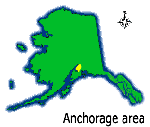
Locals often jokingly refer to the city of Anchorage as "Los Anchorage", in reference to its size and the comforts found there. And it's often said that Anchorage is "only ten minutes from Alaska", meaning that Anchorage is a world unto itself, but that the "real Alaska" is nearby. While some may disagree with those assessments, there is no denying that fishing opportunities just north and south of town can be truly outstanding, depending on the time of year and the species sought. Anglers visiting the area with limited time on their hands would do well to check out some of the places listed on this page.
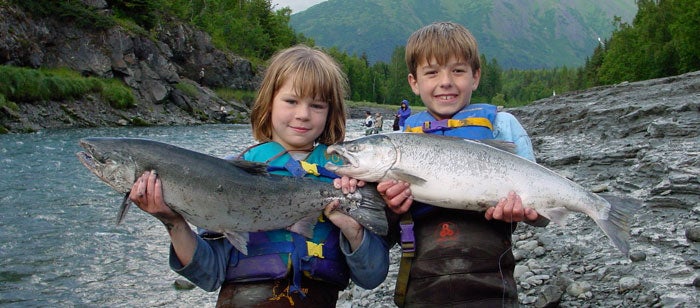
The Alaska Department of Fish and Game’s Anchorage Management Area dominates upper Cook Inlet, starting at the Eklutna (ee-kloot-na) River on the Knik (kinnick) Arm and inclusive of all freshwater lakes and streams draining into Cook Inlet over to Ingram Creek, on the Kenai Peninsula.
How This Section is Organized
Because the Anchorage Management Area offers diverse freshwater fishing opportunities, and because it serves as a base camp or "jump-off point" for fly-out or road-based freshwater and saltwater angling opportunities elsewhere, we’re breaking it down for you. This page focuses exclusively on freshwater fishing available directly in the Anchorage Management Area. Other pages in this section discuss how to access the numerous road-based and fly-out angling opportunities available if you base your trip in Anchorage.
Anchorage Management Area Basics | Fishing the Anchorage Bowl | Fishing North and South of Anchorage | Anchorage as a Base Camp
For information pertaining to specific species, including recommended gear and techniques to catch them, refer to our species pages, our fishing methods pages, and our fishing gear pages.
Species | Fishing Methods | Fishing Gear
Anchorage Fishing: What to Expect
Anchorage offers some excellent freshwater angling opportunities. Because the city sits on the shores of Cook Inlet, anglers unfamiliar with the area are sometimes surprised to learn that saltwater fishing opportunities are nonexistent in the area. This is due to a number of factors. First, Cook Inlet splits into the Turnagain Arm and the Knik Arm at Anchorage (Anchorage sits on a wedge-shaped peninsula that projects into the inlet). Both arms of the Inlet contain a lot of freshwater content from river systems draining into each arm, making the water undesirable for most marine species. The Inlet also carries a heavy load of glacial silt, which is many feet thick and is stirred up into the water column with every tide change. The water in the upper inlet is therefore completely opaque, and fish do not come here to feed. The Inlet does see runs of all five species of Pacific salmon, but these species are targeted only in the clearer freshwater streams when they return to spawn.
Available freshwater species include rainbow trout, grayling, burbot, blackfish, Dolly Varden, landlocked king and silver salmon, and limited northern pike opportunities. All five species of Pacific salmon are available, but there are no steelhead.
Notes on Ice Fishing
Ice fishing is a very popular winter activity in Anchorage, and the area lakes provide excellent opportunities. Note that motorized vehicles such as snowmachines, ATVs and highway vehicles are not allowed on Anchorage lakes during the winter months. Gas-powered ice augers are allowed. Check with the Municipality of Anchorage for specific regulations and additional details.
Run Timing Chart
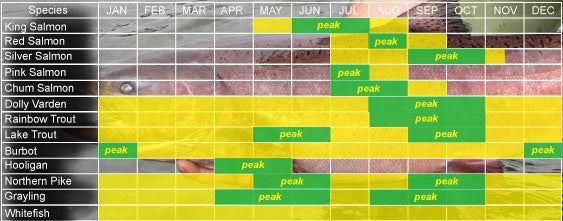
Fishing the Road System North and South of Anchorage
There are two highways that leave Anchorage; the Glenn Highway, extending north to Eagle River, Wasilla and parts north, and the Seward Highway to the south. The Seward Highway is the single conduit for road-based travel along the Turnagain Arm and on to the Kenai Peninsula. We will limit our discussion here to portions of these highways that lie within the Anchorage Management Area, which is bordered on the north by the Eklutna River, and on the south by Ingram Creek, just as the Seward Highway enters the Kenai Peninsula.
Many of the locations mapped below offer other amenities such as rest rooms, fresh drinking water and picnic facilities. Some campgrounds are available, and parking permits are required in some areas. Most lakes do not allow the use of outboard motors, though electric trolling motors may be allowed. Most lakes do not have boat ramps, so generally your best option for fishing lakes in this area is to use an inflatable boat, a canoe, or small car-topper that can be carried to the water. Many of the lakes are ideal for float-tube access, but not all of them allow shoreline access all the way around the shoreline, due to heavy vegetation or other obstacles.
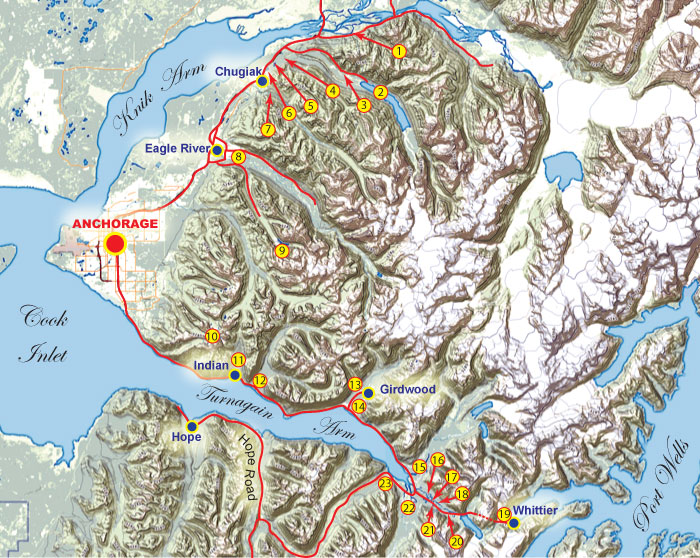
Key to Amenities
![]() Public Restrooms
Public Restrooms
![]() Drinking Water
Drinking Water
![]() Camping
Camping
![]() Picnic Tables
Picnic Tables
![]() Hiking Trails
Hiking Trails
![]() Wheelchair / ADA Access
Wheelchair / ADA Access
![]() Boat Ramp
Boat Ramp
There are two primary highways exiting Anchorage; the Parks Highway extends north of town and the Seward Highway makes its way southward along the Turnagain Arm to Portage and on to the Kenai Peninsula.
Caution: The mud along the shores of Cook Inlet is comprised of very fine glacial silt. Walking along the outlet streams that drain directly into the Inlet is extremely treacherous, and a number of people have become trapped in the mud and, unable to free themselves, drowned when the tide came in. Cook Inlet tides are some of the highest in the world, and water moves in and out very quickly. Do not walk on the tide flats!
North of Town to Eklutna: The Glenn Highway
The city of Anchorage offers a number of lakes and rivers of interest to anglers. Some of these areas are in neighborhoods and others are bordered by greenbelts or by parkland, where access may require a short walk from your vehicle.
1. Eklutna Power Plant Tailrace. Species:Species: King salmon, silver salmon. The Eklutna Power Plant Tailrace is a unique terminal fishery (the fish cannot travel upriver to spawn). The tailrace is not the natural outflow of the Eklutna River, but is an outflow of the Eklutna Dam. Water flows through a 4.7-mile penstock (a large-diameter pipe) from Eklutna Dam, through the mountain to the northwest, and down to twin turbines at the power plant. The outflow of the turbines is piped under the highway to the tailrace, which flows a short distance into the Knik River. The turbines at the power plant and the velocity of the water flowing down the mountain prevent fish from ascending to the dam. This means that this is a terminal fishery; salmon are stocked here so they can be harvested by anglers. Though some spawning undoubtedly takes place, the fishery is stocked with king salmon and silver salmon smolts every year. Fishing is popular for the length of the tailrace, and some wild fish from the Knik and Matanuska rivers are caught at the confluence of the tailrace and the Knik River.
Amenities: ![]()
2. Eklutna Lake. Species: Rainbow trout, Dolly Varden. There's a large parking lot near the lake, with a short portage trail to the lake, which is designed to accommodate hand-carried rafts, canoes and small boats. Outboard motors are prohibited on Eklutna Lake, but electric motors are allowed. Eklutna Lake is glacial in origin, and carries a heavy load of suspended glacial silt. Concentrate your fishing efforts at clearwater inlet streams for best results. Access: Exit the Glenn Highway at mile 26.3, travel east to the Eklutna Lake Recreation Area.
Amenities: ![]()
![]()
![]()
![]()
![]()
3. Eklutna River. Species: Chum salmon, silver salmon, Dolly Varden. Background: In 1928 two dams were built at the outlet of Eklutna Lake. A low-head storage dam was built at the outflow of the lake, and a diversion dam was constructed eight miles downstream, for the purpose of diverting water through a 1/4-mile tunnel to a power plant near the village of Eklutna. In 1948, significant upgrades were made to the upper dam, which raised the level of Eklutna Lake. At the same time, water was diverted at the upper dam, through a 4.5-mile-long tunnel through the mountain, to a new power plant on the banks of the Knik River. The new dam incorporates an unregulated spillway that allows some water to escape in years of high water, but the new dam and tunnel diverts the entire flow of the Eklutna River most of the time. Several tributary streams flow into the river valley, however, the largest of which is Thunderbird Creek. The Eklutna River still exists, therefore, but not as an outflow of Eklutna Lake. Access: Follow the Glenn Highway north of Anchorage and take the Eklutna exit at MP 26.3. Continue a short distance to the Eklutna bridge. There's a parking lot in the area and a trail leading a mile or so up to Thunderbird Falls. Limited access is possible upriver via the access road to Eklutna Lake, however the area contains a lot of private land.
Amenities: ![]()
4. Thunderbird Creek. Species: Silver salmon, Dolly Varden. Thunderbird Creek is a glacial stream with very limited fishing opportunities. Few silvers make their way up the creek and any Dolly Varden encountered will be small and hard to find. Access: Potential access off of the Thunderbird Creek trail, but terrain is very steep and treacherous. See Eklutna River access information for Thunderbird Creek trail info.
Amenities: ![]()
5. Edmonds Lake. Species: Rainbow trout (stocked). Access: Travel north on the Glenn Highway and turn off at MP 23.6. At the "Tee" intersection, go left 1.3 miles to Paradise Lane, right .5 mile to South Hill. Lake is a short distance to the right.
Amenities: None
6. Mirror Lake. Species: Arctic Char (stocked), Rainbow trout (stocked), landlocked king salmon. Access: North on Glenn Highway to MP 15.3, southeast to sign, turn right a short distance to the lake. Note that some of the land around the lake is private. To fish these areas, a float tube or canoe is recommended to avoid trespass.
Amenities: None.
7. Peters Creek. Species: King and silver salmon (king salmon fishing is prohibited), Dolly Varden. Salmon fishing is prohibited upstream of the Glenn Highway bridge, however the lower reaches are popular during the silver run. Peter's Creek is a clearwater stream coming out of Chugach State Park and draining into the Knik Arm just north of the Birchwood Airport. Access: Turn off the Glenn Highway north of Anchorage at MP 20.9 (North Birchwood exit). Continue south of the highway to the intersection with the Old Glenn Highway. Turn left and travel a short distance to the bridge over Peter's Creek. Fishing upstream of the bridge is best accessed via the Peter's Creek Valley Trail, but the trail runs about 1/3 of a mile up the mountain north of the creek for most of the distance. It's fairly steep and brushy from the trail down to the creek, and the creek's banks are choked with brush. Access is difficult. Downstream of the bridge, the creek is bordered much of the way by private land, but there are at least two bridges over the creek in that area. For most of it's length, the creek is swift, shallow and rocky.
Amenities: A private RV campground is in the area ![]()
![]()
![]()
![]()
![]()
![]()
![]()
8. Eagle River. Species: King salmon, silver salmon, Dolly Varden. Eagle River is a glacial stream that flows mostly from headwater streams flowing out of a half-dozen glaciers in Chugach State Park. Owing to the heavy load of glacial silt, artificial lures offer slim prospects of success. Bait, particularly salmon roe, is the preferred option where possible. The exceptions are any of several clear tributaries that merge with Eagle River. The waters at these confluences can offer some chance for flyfishing and other artificial lures. Access: The portion of Eagle River downstream of the Glenn Highway bridge is accessible from certain locations on JBER. See our section on JBER for more details. Upstream of the Glenn Highway bridge, the river is accessible in several locations. Some opt to float Eagle River, however, but this should only be attempted by those with whitewater experience. The river's icy cold water, combined with numerous whitewater sections and logjams and the heavy silt load make this river very dangerous at times. The south fork offers clear water and fishing prospects are easier, however the south fork is choked with brush and bordered by private land in it's lower reaches and very small. Anglers may find some smaller Dolly Varden there, but it will be slim pickings.
Amenities: Eagle River Campground offers some amenities, and there are hiking trails upriver. ![]()
![]()
![]()
![]()
![]()
![]()
![]()
9. Symphony Lake. Species: Grayling. Access: Drive north from Anchorage on the Glenn Highway to MP 11.6. Right on Hiland Road seven miles up the South Fork Eagle River valley to the trail head. Hike five miles into Chugach State Park to Symphony Lake.
Amenities: ![]()
South of Town to Ingram Creek: The Seward Highway
10. Rabbit Lake. Species: Rainbow trout. Access: Drive south of Anchorage on the Glenn Highway to MP 15.2. Park at the McHugh Creek trailhead and hike 7 miles in to Rabbit Lake.
Amenities (McHugh Picnic Area): ![]()
![]()
![]()
![]()
11. Indian Creek. Species: Pink salmon, Dolly Varden. Access: Seward Highway to MP 103.
Amenities: None
12. Bird Creek. Species: Pink salmon, silver salmon, chum salmon, Dolly Varden. Bird Creek is the most popular fishery in Upper Cook Inlet, particularly during the pink and silver runs. The pink salmon run peaks in even-numbered years. The area is tidally-influenced and the banks are very muddy with glacial silt. Use extreme caution walking in this mud, and avoid walking on the mud flats below the bridge. Anglers have become stuck in the mud and have drowned as the tide comes in. Access: South on Seward Highway to MP 101.2. Park in designated parking area either west of the creek or in the smaller lot east of Bird Creek, and take the pathways down to the bridge.
Amenities: ![]()
![]()
![]()
![]()
![]()
![]()
![]()
13. California Creek. Species: Sockeye salmon, pink salmon, chum salmon, Dolly Varden. California Creek is a clear stream draining out of the Chugach Mountains near Alyeska. Some fishing is possible in the upper reaches, but access is difficult. Best spot is at the confluence with Glacier Creek. Access: South on Seward Highway to Girdwood. Turn off of the Seward Highway onto the Alyeska Highway. Take the first right after the gas station and make your way east to Gold Avenue. Go east on Gold Avenue to the banks of Glacier Creek. Walk upriver to the railroad trestle and on to the confluence of California Creek and Glacier Creek.
Amenities: None
14. Glacier Creek. Species: Pink salmon, Dolly Varden, cutthroat trout. This is a glacial stream with high turbidity, consequently fishing is usually poor in the main stream. Try upriver in late fall. When the glacier freezes, water levels drop and clear. The best place to fish is in the lower river at the California Creek confluence. Access: See instructions for California Creek above.
Amenities: None
15. Twentymile River. Species: Silver salmon, hooligan. Alaska residents are allowed to dipnet for hooligan, and the Twentymile River is the most popular hooligan fishery in the state. Dip netting is done near the Seward Highway bridge, however some dip netters actually work the inlet itself, a few miles toward Anchorage from the Twentymile River. Some silver fishing happens near the Twentymile bridge, however fishing is much better in clearwater tributaries upriver, which are only accessible by boat. There are no facilities at Twentymile, so, as always, be prepared to pack out all your trash. Restroom facilities are available at various campgrounds along the Portage Glacier Road or back at Girdwood. Access: South on Seward Highway to MP 81. Park on either the left or right side of the highway (there are turnouts).
Amenities: ![]()
16. Tangle Pond. Species: Landlocked king salmon, arctic char, rainbow trout (all species are stocked). Access: South on Seward Highway to Portage Glacier Road. Turn off at MP 2.3 to the pullout on the north side of the road.
Amenities: None. Restroom facilities are available at various campgrounds along the Portage Glacier Road.
17. Airstrip Pond. Species: Arctic char, grayling, rainbow trout (stocked). Access: South on Seward Highway to Portage Glacier Road. Turn off at MP 1.0 to the paved access road on the north side of the highway.
Amenities: None. Restroom facilities are available at various campgrounds along the Portage Glacier Road.
18. Portage Creek. Species: Pink salmon, silver salmon, sockeye salmon, chum salmon, Dolly Varden. Portage Creek is a glacial stream draining out of Portage Lake. The lower reaches are tidally-influenced, and bordered by fine glacial silt. The lower river splits into two channels before flowing under the Seward Highway. The middle and upper sections are popular day float trips. Angling is best at clearwater tributaries. Access: South on Seward Highway to Portage Glacier Road.
Amenities: ![]()
![]()
![]()
![]()
![]()
![]()
![]() (amenities vary depending on the campground you visit in the Portage Valley).
(amenities vary depending on the campground you visit in the Portage Valley).
19. Whittier (marine fishery). Species: Pink salmon, silver salmon, chum salmon, Dolly Varden, herring. Whittier offers a number of marine and freshwater opportunities which are covered in our Kenai Peninsula Fishing section. This is just a very brief overview. Access: South on Seward Highway to Portage Glacier Road. Take Portage Glacier Road to the railroad tunnel, drive through the Anton Andersen Memorial Tunnel to Whittier. Note that the tunnel operates on a schedule to allow railroad traffic, as well as inbound and outbound vehicle traffic. Plan accordingly. The tunnel is operated by the D.O.T. and the schedule can be found AT THIS LINK.
Amenities: ![]()
![]()
![]()
![]()
![]()
![]()
![]()
![]() Note: Whittier has restaurants, overnight lodging and many more amenities, which are covered in our Kenai Peninsula section.
Note: Whittier has restaurants, overnight lodging and many more amenities, which are covered in our Kenai Peninsula section.
20. Williwaw Creek. Species: Silver salmon, sockeye salmon, chum salmon, Dolly Varden. Note that Williwaw Creek is closed year-round to salmon fishing. Access: South on Seward Highway to Portage Glacier Road. Continue along Portage Glacier Road past the Black Bear Campground to the bridge over Williwaw Creek. Park and walk down the creek to the confluence with Portage Creek. The confluence area offers clear holding water for salmon and Dolly Varden.
Amenities: ![]()
![]()
![]()
![]()
![]()
![]()
![]() (amenities vary depending on the campground you visit in the Portage Valley).
(amenities vary depending on the campground you visit in the Portage Valley).
21. Alder Pond. Species: Rainbow trout (stocked). Access: South on Seward Highway to Portage Glacier Road. Continue on Portage Glacier Road 1.25 miles to access road on the south side of the highway. Follow access road to "Y" intersection, turn left to pond access.
Amenities: ![]()
![]()
![]()
![]()
![]()
![]()
![]() (amenities vary depending on the campground you visit in the Portage Valley).
(amenities vary depending on the campground you visit in the Portage Valley).
22. Placer River. Species: Silver salmon, Dolly Varden. Access: Drive south on the Seward Highway to MP 78.4. There is a turnout where you can park. Access along the Placer is very brushy with a chance of bears during salmon season. The Alaska Railroad tracks lead to a trestle over the Placer River, but access via the tracks is strictly prohibited and fines are heavy.
Amenities: None
23. Ingram Creek. Species: Pink salmon, silver salmon, Dolly Varden. Access: Drive south on the Seward Highway onto the Kenai Peninsula, just past Portage. The highway crosses the river at MP 75.3.
Amenities: ![]()
Be Bear-Aware!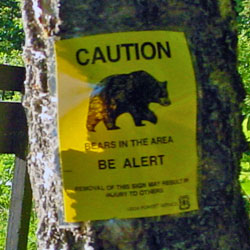
Alaska is bear country! Anglers must be aware of the possibility of encountering bears along any salmon stream. and some people are surprised to discover that brown bears are relatively common even in the heart of Anchorage. This is particularly true along any of the four salmon streams in Anchorage. The upper reaches of Ship Creek, and extending west of Reeve Blvd. can contain occasional bears, especially in brushy areas above the Ship Creek Dam. Chester Creek and Campbell Creek flow through the heart of Anchorage, and each is bordered for much of its length by a brushy greenbelt that provides cover for bears looking for salmon in mid to late summer. Rabbit Creek may also harbor bears, but this stream is choked with brush and not as commonly fished. Take the following precautions:
- Make plenty of noise while hiking or fishing.
- Don’t give bears a reason to associate people with food! Keep food and your catch in a backpack on your back.
- Protect yourself! Bring a pepper spray to use as a deterrent. The discharge of firearms within city limits is prohibited, though you are allowed to carry a firearm with you. Alaska's firearms laws are very liberal, though there are some places in town where you are prohibited from carrying a gun. Check the local regulations or contact the Anchorage Police Department for clarification. If you choose to use a firearm as a primary bear defense weapon in town, first consider the risks of discharging a weapon in circumstances where brush and vegetation may obscure the area near or behind the charging bear, creating a risk of injury to others in the area.
Elsewhere in this Section
We've broken the Anchorage Management Area into smaller pieces, so you can focus on your particular area of interest. Here's an overview:
Orientation to the Anchorage Management Area
This section deals with some of the basic information you need to know about this area; a brief history of the area, the layout of the area, safety concerns (including dealing with the local wildlife), and available services.
Fishing The Anchorage Bowl
This page deals with fishing opportunities in Anchorage itself, and JBER, the military base just north of town.
Fishing North and South of Town (this page)
There are a lot of places to fish on the road system north and south of Anchorage. This page lists them in detail, along with available species and amenities.
The Seward Highway South to Ingram Creek
Beginning at Potter Marsh, a popular wildlife viewing area on the south end of Anchorage, the Seward Highway extends southward along the Turnagain Arm of Cook Inlet, to Portage and on to the Kenai Peninsula. The highway forms a narrow border between the steep, rugged Chugach Mountains and the treacherous tidal flats of the Turnagain Arm. There are several good fishing areas in this zone, which are covered in our "Anchorage: Just out of Town" page.
The Parks Highway North to Eklutna
The George Parks Highway begins at the north end of Anchorage, and extends northward 350 miles to Fairbanks. But the Anchorage Management Area extends only to the Ekutna River, which is covered in our "Anchorage: Just out of Town" page. Check it out!
Anchorage as a Base Camp
Lots of people base their fishing adventures out of Anchorage, either driving or flying out to adventures in other parts of South-Central Alaska or beyond. This page will get you started!
Area Sponsor
Classic Alaska Charters offers excellent overnight custom cruises aboard the “Saltery C”, their fully-outfitted 40’ live-aboard Bayliner Explorer Motoryacht. Each trip is an adventure customized to your requirements. Meals prepared by the onboard chef are unequalled in the business, and include healthy entrees such as fresh Alaska seafood and delicious desserts. Activities include fishing (freshwater and saltwater), kayaking, wildlife viewing, photography, crabbing & shrimping, hiking and just relaxing along the spectacular waterways of Ketchikan, Prince of Wales Island and Misty Fjords National Monument.
CAC is a US Coast Guard certified & registered guide / outfitter with the US Forest Service and ADF&G. Adcanced booking required… 6-12 months in advance, at least! Ketchikan Alaska fishing with Captain Rob is a true wilderness experience! We also have our Federal Halibut Permit for 6 anglers. Call or This email address is being protected from spambots. You need JavaScript enabled to view it. ! We’d love to have you aboard! 1 (907) 225-0608.
Need More Information?
Check out our other Anchorage Management Area fishing pages!
Anchorage Management Area Basics | Fishing the Anchorage Bowl | Fishing North and South of Anchorage | Anchorage as a Base Camp
If you’re looking for other areas to fish in Southcentral Alaska, check out our pages for the following areas:
Southcentral Fishing | MatSu Fishing | Southcentral Boat Launches
If you’re interested in hunting opportunities in Southcentral Alaska, check out our hunting pages at the following links:
Southcentral Hunting | MatSu Hunting
Rules and Regulations
The Alaska Department of Fish and Game is responsible for maintaining the sport fisheries across the state of Alaska. Their website provides a wealth of information about our sport fisheries as well as the regulations you need to know. Additionally, the Department issues Emergency Orders throughout the season, that have a direct bearing on last-minute changes in bag limits, openings and closings of seasons and much more. Fishermen are responsible for knowing the regulations, including these Emergency Orders. You can find all of that information and more at the Alaska Department of Fish and Game’s website, or at the regional office in the area where you are fishing.
ADF&G Sportfisheries DivisionAnchorage Office:Alaska Department of Fish and Game
333 Raspberry Road
Anchorage, AK 99518
1 (907) 267-2186
